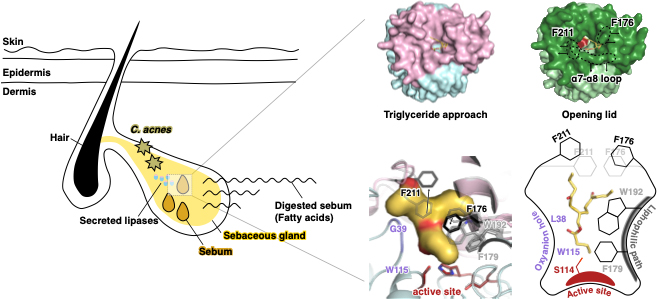More than skin-deep
Acne can have an enormous social and emotional effect on the 85% of adolescents and 40% of adults who have it. Hyo Jung Kim and colleagues in the Republic of Korea recently published a paper in the Journal of Lipid Research describing the molecular structure of a key enzyme involved in the skin disorder. This research has the potential to pave a path for new acne treatments.
The top two skin layers are the epidermis, forming the waterproof barrier, and the dermis, consisting of hair follicles and sweat glands surrounded by connective tissue. In the dermis next to hair follicles are sebaceous glands that secret sebum, a complex mixture of lipids including triglycerides and their derivatives. Acne is chronic inflammation of the sebaceous follicles, resulting in skin elevations such as papules, pustules and cysts that can lead to scarring.
Research into causes of acne focuses on Cutibacterium acnes, a Gram-positive bacterium typically found on healthy human skin, where it helps block pathogens. Specifically, C. acnes secretes lipases that break down lipids in the sebum and release fatty acids that form a protective layer on the skin surface. However, C. acnes colonization of inflamed sebaceous follicles contributes in an as-yet-unknown wayto the development of acne.
Recent research supports the idea that acne is caused by imbalances in the C. acnes subtypes and their respective lipases. Specifically, C. acnestype I subclass, called IA, is associated strongly with acne and displays higher lipase secretion and activity than C. acnes type II, which is associated with healthy skin. Excessive production of fatty acids can promote inflammation, so differences in lipase secretion and activity could be a major driver in acne development.

researchers solved the structure of a highly conserved C. acnes lipase. The image shows an active site gating mechanism
involving the formation of a lid by two key phenylalanines.
In this study, the investigators solved the structures of C.acnes type II lipase by X-ray crystallography in three states: closed, blocked and open. Corresponding author Ae-Ran Kwon explained the research strategy: “The structures solved by X-ray crystallography are often compared to still images. Once you combine several images together you can extract information analogous to a moving animation, so you can see how the protein works.”
Specifically, the researchers found a novel active site gating mechanism, with two key phenylalanine residues forming a lid on top of the active site that controls lipase activity. Since this lipase is highly conserved across C.acnessubtypes, this research also applies to the acne-associated IA.
Acne treatments such as benzoyl peroxide, retinoid and antibiotics focus only on symptoms and can have undesirable side effects. Kwon, Kim and colleagues at Daegu Haany University and Woosuk University are working to design compounds that selectively block this lipase.
“Since the lipase is secreted protein, this can be a good target for topical treatment,” Kim said. “We can limit the application area to a local site of infection.”
Kim recalled suffering from mild acne breakouts when she felt stressed as a teen. “I would get so self-conscious, lose confidence in face-to-face conversation and even postpone my dates,” she said. She is confident about the high market demand for improved acne treatments.
Enjoy reading ASBMB Today?
Become a member to receive the print edition monthly and the digital edition weekly.
Learn moreGet the latest from ASBMB Today
Enter your email address, and we’ll send you a weekly email with recent articles, interviews and more.
Latest in Science
Science highlights or most popular articles

Decoding microglial language
Emory University scientists characterize extracellular vesicles that facilitate intercellular communication.

What is metabolism?
A biochemist explains how different people convert energy differently – and why that matters for your health.

What’s next in the Ozempic era?
Diabetes, weight loss and now heart health: A new family of drugs is changing the way scientists are thinking about obesity — and more uses are on the horizon.

How a gene spurs tooth development
University of Iowa researchers find a clue in a rare genetic disorder’s missing chromosome.

New class of antimicrobials discovered in soil bacteria
Scientists have mined Streptomyces for antibiotics for nearly a century, but the newly identified umbrella toxin escaped notice.

New study finds potential targets at chromosome ends for degenerative disease prevention
UC Santa Cruz inventors of nanopore sequencing hail innovative use of their revolutionary genetic-reading technique.

